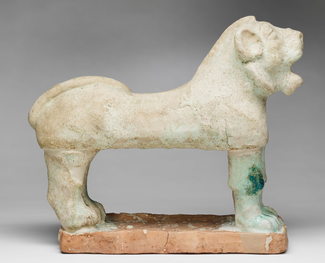The Core of a New Age: Northern Mesopotamia and Syria in the Late Bronze Age
This article first appeared in ISAW Newsletter 17, Winter 2017.
Conference, organized by Beate Pongratz-Leisten (ISAW) and Lorenzo d’Alfonso (ISAW
 Lion, Glazed terracotta, 38.8 x 14 x 37 cm, Yorghan Tepe, Iraq 1500-1350 BCE, Mitannian period, Harvard Art Museums/Arthur M. Sackler Museum, 1931.162.A. Photo © President and Fellows of Harvard
During the Late Bronze Age, northern Mesopotamia consists of two major regions that highly differ in their political trajectories. East of the Euphrates, two major powers grew prominent, one after the other, and became major players in what is known as the age of diplomacy: one is the kingdom of Mittanni, the other is Assyria. West of the Euphrates, instead, we see a fragmented political landscape with local kingdoms wavering between the major powers. The two regions, however, strongly interacted from very early times in history; with the Late Bronze Age, the expansion of the kingdom of Mittanni and Assyria toward the west promoted and intensified the interaction between local interests and external hegemonic pursuits in the administrative, political, cultural and economic spheres. The aim of the workshop is to reflect on the settlement patterns, agrarian landscapes, transmissions of knowledge, circulations of people and goods, and conceptualization of power in northern Mesopotamia and Syria. The central question to be explored is how and in which contexts can we observe a common ideology reflecting this intersecting of political, economic, and social frameworks of the Club of Great Powers.
Lion, Glazed terracotta, 38.8 x 14 x 37 cm, Yorghan Tepe, Iraq 1500-1350 BCE, Mitannian period, Harvard Art Museums/Arthur M. Sackler Museum, 1931.162.A. Photo © President and Fellows of Harvard
During the Late Bronze Age, northern Mesopotamia consists of two major regions that highly differ in their political trajectories. East of the Euphrates, two major powers grew prominent, one after the other, and became major players in what is known as the age of diplomacy: one is the kingdom of Mittanni, the other is Assyria. West of the Euphrates, instead, we see a fragmented political landscape with local kingdoms wavering between the major powers. The two regions, however, strongly interacted from very early times in history; with the Late Bronze Age, the expansion of the kingdom of Mittanni and Assyria toward the west promoted and intensified the interaction between local interests and external hegemonic pursuits in the administrative, political, cultural and economic spheres. The aim of the workshop is to reflect on the settlement patterns, agrarian landscapes, transmissions of knowledge, circulations of people and goods, and conceptualization of power in northern Mesopotamia and Syria. The central question to be explored is how and in which contexts can we observe a common ideology reflecting this intersecting of political, economic, and social frameworks of the Club of Great Powers.